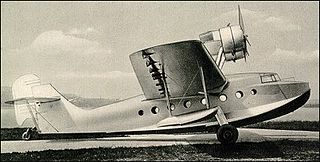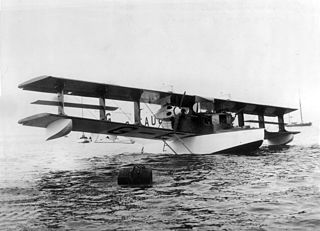
The Miles M.14 Magister is a two-seat monoplane basic trainer aircraft designed and built by the British aircraft manufacturer Miles Aircraft. It was affectionately known as the Maggie. It was authorised to perform aerobatics.

The Dornier Do 24 is a 1930s German three-engine flying boat designed by the Dornier Flugzeugwerke for maritime patrol and search and rescue. A total of 279 were built among several factories from 1937 to 1945.

The AD Flying Boat was designed by the British Admiralty's Air Department to serve as a patrol aircraft that could operate in conjunction with Royal Navy warships. Intended for use during the First World War, production of the aircraft was terminated as the end of the war came into sight, and the type saw little operational use. A number were repurchased after the end of the war by Supermarine Aviation and rebuilt as civil transports, becoming known as the Supermarine Channel.
The ACME Anser was an amphibious twin-jet utility aircraft that was developed in the United States by Air Craft Marine Engineering in 1958. The project was cancelled before the prototype was complete.

The Antonov An-14 Pchelka or Pchyolka, Bdzhilka is a Soviet utility aircraft which was first flown on 15 March 1958. It was a twin-engined light STOL utility transport, with two 300 hp Ivchenko AI-14RF radial piston engines. Serial production started in 1966, and about 300 examples were built by the time production ended in 1972. The An-14 failed to replace the more successful An-2 biplane, which was manufactured until 1990,. The An-14's successor, the An-28 with turboprop engines, is still manufactured at PZL Mielec factories in Poland, under the names PZL M28 Skytruck and PZL M28B Bryza.

The Beriev Be-103 is an amphibious seaplane designed by Beriev and constructed by the Komsomolsk-on-Amur Aircraft Production Association (KnAAPO) in Russia. Intended for autonomous operation in the unmarked areas of Russia's far north and Siberia, the Be-103 was designed for short-haul routes in regions that have rivers, lakes and streams, but are otherwise inaccessible.

The Supermarine Seagull was a British amphibious, military flying boat and the last to be built by the Supermarine company. Design started during the Second World War but it did not fly until three years after the war had ended and the project was cancelled without it being adopted for service.

The General Aircraft G.A.L.38 Fleet Shadower was a British long-range patrol aircraft design of the immediate pre-Second World War period. The Fleet Shadower was a highly specialized aircraft intended to follow enemy naval task forces over long times and radio back position information. However, the concept produced an ungainly and ultimately unsuccessful type. The Airspeed Fleet Shadower, built to the same requirement and of broadly similar appearance, also did not progress past the prototype stage.

The Latécoère 631 was a civil transatlantic flying boat built by Latécoère, the largest ever built up to its time. The type was not a success, being unreliable and uneconomic to operate. Five of the eleven aircraft built were written off in accidents and one was lost during World War II.

The Dornier Komet ("Comet"), Merkur ("Mercury"), Do C, Do D, and Do T were a family of aircraft manufactured in Germany during the 1920s, originally as small airliners, but which saw military use as well. The earliest aircraft in the series were basically landplane versions of the Delphin flying boat, and although the Delphin and Komet/Merkur series diverged from each other, design changes and refinements from one family were often incorporated into the other. All variants were braced high-winged single-engine monoplanes with conventional landing gear.

The Supermarine Commercial Amphibian was a passenger-carrying flying boat. The first aircraft to be designed by Supermarine's Reginald Mitchell, it was built at the company's works at Woolston, Southampton, for an Air Ministry competition that took place during September 1920. Based on the Supermarine Channel, the Amphibian was a biplane flying boat with a single engine, a wooden hull, unequal wingspans and a 350 horsepower (260 kW) Rolls-Royce Eagle engine. The pilot sat in an open cockpit behind two passengers.

The Supermarine Seal II was a British flying boat developed by Supermarine after it secured a British Air Ministry order for a prototype three-seater fleet spotter amphibian. The prototype, which had to be capable of landing on Royal Air Force (RAF) aircraft carriers, was designed by Supermarine's R.J. Mitchell, who incorporated suggestions made after the Supermarine Commercial Amphibian achieved second place after it was entered for an Air Ministry competition in 1920.

The Macchi M.C.94 was a 1930s Italian commercial flying boat built by Macchi.

The Fokker F-11 was a luxury flying boat produced as an 'air yacht' in the United States in the late 1920s. Technically the aircraft was the Fokker Aircraft Corporation of America's Model 9. It was sold in North America as the Fokker F-11 and was offered in Europe as the Fokker B.IV. By the time the first six aircraft had been constructed, it was already evident that the design was not going to sell well. A few were sold, two to notable multi-millionaires; Harold Vanderbilt and Garfield Wood each purchasing one. One was bought by Air Ferries in San Francisco. The F-11A cost $40,000 but the price was slashed to $32,500 as the depression set in during 1930. The F-11 was a commercial failure.

The Lioré et Olivier LeO H-47 was a flying boat airliner built in France in 1936. It was designed to operate passenger services over the South Atlantic, but the outbreak of the Second World War caused the type to be used by the French Navy as a maritime patrol aircraft.
The Saro A.33 was a British prototype flying boat built by Saunders-Roe Limited in response to a British Air Ministry Specification R.2/33 and in competition with the Short Sunderland.

The Saunders Kittiwake was a British amphibian flying-boat built by S. E. Saunders at East Cowes, Isle of Wight. Only one was built, and it was scrapped after less than a year of testing.
The Nikitin MU-4 was an amphibian trainer aircraft produced in the USSR in 1936.
The TA was an amphibious transport designed and built in the USSR in 1945.
The Shavrov Sh-5 was a Soviet civil amphibian flying-boat designed by Vadim Borisovich Shavrov as a photographic platform for aerial mapping. By the time it flew it was an outdated design and the type did not enter production.















